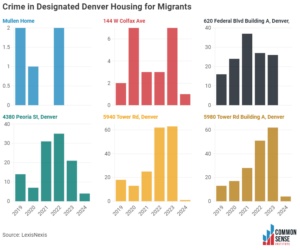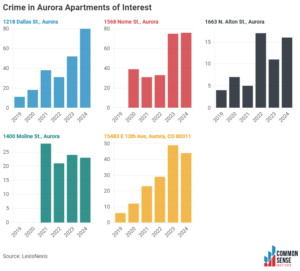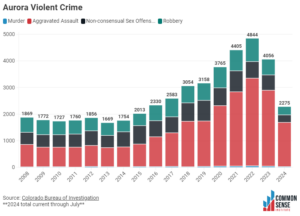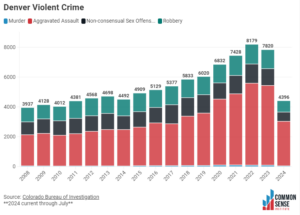Introduction
Aurora, Colorado’s third-largest city, has made local and national headlines recently for criminal activity in apartment buildings allegedly related to members of a Venezuelan gang. City officials, media commentators, and the public have debated at length the reputed presence of Venezuelan gang Tren de Aragua and the extent of the gang’s criminal activity across the Metro Denver area.
Although crime in Aurora and Denver is still above its pre-pandemic baseline, neither has experienced city-wide elevated crime levels in the last 12 months. However, several areas throughout the cities with documented elevated migrant populations have seen dramatic upticks in crime in 2023 and 2024.
Importantly, these trends are not uniform across all centers of migrant populations. The isolated crime that is being committed in the areas in question at apartments on Dallas Street, Nome Street, and 13
th Avenue is borne by the surrounding areas, most of which are neighborhoods with lower socioeconomic status. There are economic costs associated with this rise in crime.
Key Findings
- Aurora’s violent crime is not rising as a whole. Violent crime in both Aurora and Denver has decreased since a 2022 peak, though in 2023 annual crime remained elevated from crime in 2019.
- Identifying crime trends is difficult among noncitizens, as reporting is lower. Cities are estimated to have a 6% decrease in violent crime reporting and 1% decrease in property crime reporting for every 1% increase in noncitizen residents. The recent migrant surge has resulted in a 12% increase in the number of noncitizens in the Denver metro area.
- Publicly available geolocated crime maps do not show a consistent trend of rising crime in the Denver or Aurora locations known to house high numbers of migrants. However, they do show a localized spike in police- reported crime at three Aurora complexes.
- The apartments at 1218 Dallas Street in Aurora have seen crimes and citations more than double since 2022, from 31 to 80.
- The apartments at 1568 Nome Street in Aurora have seen crimes and citations more than double since 2022, from 33 to 76.
- The apartments at 15483 E 13th Avenue Aurora have seen crimes and citations nearly double since 2022, from 29 to 44.
- Elevated crime has higher costs on economically disadvantaged neighborhoods. The major crimes in 2024 at just the Dallas Street apartments alone have led to $700,000 in tangible and intangible costs. These do not include crimes not reported to police.
Aurora Apartment Crime
Apartment complexes in Aurora have ignited a storm of interest from the public after armed men were caught on camera in a building hallway. This triggered concerns about a Venezuelan prison gang known to operate in Colorado since mass migration of Venezuelans began in 2022. Whether attached to a gang or the result of landlord neglect, some properties have indeed seen sharp upticks in crime while similar properties have not.
Areas of interest include apartment complexes at 1218 Dallas St., 1568 Nome St., 15483 E 13th Avenue, 1663 N. Alton St, and the 1400 block of Moline St.
The Dallas Street buildings have commanded the most media attention.
The Dallas Street apartments have indeed seen a dramatic increase in the number of crimes and citations in the last two years. The annual number of crimes and citations rose from 31 in 2022 to 52 in 2023. Through the end of August alone, there have been 80, a 158% increase from 2022.[i]
Figure 1 - Crime in Aurora Areas of Interest

These range from aggravated assault to traffic violations. Among the more major incidents are one arson, three simple assaults, 11 aggravated assaults, five burglaries, one vandalism, seven instances of fugitive from justice, one prostitution, three disorderly conducts, and one robbery.
The apartments at 1568 Nome St. have been under similar media scrutiny. As with the Dallas Street apartments, the number of crimes and citations at that location has risen in the last two years. In 2022, there were 33 crimes and citations at the location. That rose to 75 in 2023 and 76 in 2024 to date.
The Whispering Pines apartments at 15483 E 13th Avenue in Aurora have seen the same increase. The number of crimes and citations shot from 29 in 2022 to 49 in 2023 and 44 in 2024 to date.
Other apartments in Aurora that have been observed as having high numbers of migrants have charted the same increase in crime and citations, but these began in 2022 before Denver’s migrant inflow reached its peak. Apartments on Alton Street saw crimes and citations rise from five in 2021 to 17 in 2022 before falling to 11 in 2023 and 16 in 2024 through August.
The residences set up by the City of Denver to temporarily house incoming migrants[ii] have not seen the same sharp uptick in crimes and citations as the two Aurora apartment complexes, with one exception.
Figure 2 - Crime In Designated Denver Housing For Migrants

Buildings at the Archdiocese of Denver’s Little Sisters of the Poor, 144 W. Colfax Avenue, 620 Federal Boulevard, and 4380 Peoria Street have seen their numbers remain largely flat. At 5940 Tower Road, Building A, crime and citations have been rising consistently since 2019, from 13 in 2019 to 63 in 2023. Crime in 2024 has been comparatively non-existent, with only four crimes and citations recorded to date.
Crime in Aurora and Denver
The apartment complexes under scrutiny in Aurora do not reflect a citywide increase in violent crime, nor do they reflect an increase in Denver. However, there are observed differences in crime reporting in immigrant communities that makes establishing any related trends difficult.
Violent crime has been decreasing in Aurora from its recent peak in 2022. That year there were 4,844 violent crimes including murder, aggravated assault, robbery, and non-consensual sexualassault. That declined to 4,056 in 2023.
Figure 3 - Aurora Violent Crime

Similarly, Denver’s violent crime has been declining from a 2022 peak, when there were 8,179 violent crimes citywide. In 2023, that had decreased to 7,820.
Figure 4 - Denver Violent Crime

Crimes are frequently underreported. This is accounted for in CSI’s cost of crime analysis as provided by the Miller model (Figure 5). The literature has recognized, however, that they are more frequently underreported in immigrant communities.
According to the National Library of Medicine, noncitizen growth corresponds with a greater likelihood of unreported crime. In the years between 1990 and 2000, a 1% increase in noncitizen population decreased odds of violent crime reporting by about 6%. A 1% increase in noncitizen population decreased odds of property crime reporting by about 1%.
“Metropolitan areas that experienced rapid influx by immigrants during the 1990s therefore appear to suffer substantial levels of underreporting of violent crime to the police relative to cities that did not experience such growth in the share of their noncitizen populations.”[iv]
Estimates placed 352,100 noncitizen residents in the Denver metro with 2022 data. The approximately 42,000 largely Venezuelan migrants who arrived in Denver from late 2022 through the present will have increased the city’s noncitizen population by 12%.
Costs of Crime
Traceable to a particular set of criminals or not, local crimes carry local economic consequences. In the case of the Aurora apartment complexes, the uptick in crimes results in close to a million dollars of localized impact. This exacerbates the fact that the costs are borne by a comparatively disadvantaged community.
The Dallas Street apartments are a lower-income neighborhood. The Arapahoe County census track they inhabit is among the poorer in the Denver metro, with only 66% employed, only 16% possessing a bachelor’s degree or higher, and a median household income of $61,058.
[iii] It is heavily Hispanic, with 2,198 Hispanic or Latino residents in tract of 1,337 total households. The Nome Street apartments exist in a census tract with very similar figures.
To estimate the tangible and intangible cost of crime in Colorado, CSI utilized a model by Miller,
et al., published in the Journal of Benefit-Cost Analysis titled “Incidence and Costs of Personal and Property Crimes in the United States, 2017.”
[v] In this report, all cost estimates are converted to 2024 dollars.
Figure 5 below shows the various police reported crime incidents that occurred at Dallas Street Apartments in 2024 year-to-date. Using the crime cost model, CSI estimates the total cost of these crimes to be over $700,000 in both tangible and intangible costs. These do not include lower-level crimes.
Figure 5 – Cost of Crimes in 2024 at Dallas Street Apartments
| Cost of Crimes in 2024 at Dallas Street Apartments |
|
|
2017 Cost per Incident |
2017 Total Cost per Category |
2024 Cost per Incident |
2024 Cost per Category |
| Arson |
1 |
$39,438 |
$39,438 |
$50,313 |
$50,313 |
| Simple Assault (non-violent) |
3 |
$2,349 |
$7,047 |
$2,997 |
$8,990 |
| Agg. Assault |
11 |
$38,784 |
$426,624 |
$49,478 |
$544,262 |
| Burglaries |
5 |
$5,369 |
$26,845 |
$6,849 |
$34,247 |
| Vandalism |
1 |
$1,349 |
$1,349 |
$1,721 |
$1,721 |
| Fug. From Justice |
7 |
N/A |
N/A |
N/A |
N/A |
| Prostitution |
1 |
$444 |
$444 |
$566 |
$566 |
| Dis. Conduct |
3 |
$1,819 |
$5,457 |
$2,321 |
$6,962 |
| Robbery |
1 |
$43,768 |
$43,768 |
$55,837 |
$55,837 |
| Respective Year Total |
|
|
$550,972 |
|
$702,898 |
Bottom Line
Aurora’s violent crime is not rising as a whole, though identifying crime trends is difficult among noncitizens, as crime reporting is lower. Publicly available geolocated crime maps do not show a consistent trend of rising crime in the Denver or Aurora locations known to house high numbers of Venezuelans. However, they do show a localized spike in crime at two Aurora apartment complexes. The costs of $700,000 in local economic loss will be felt more strongly in the economically disadvantaged neighborhoods.
[i] https://communitycrimemap.com/
[ii] https://www.denvermigranthelp.com/
[iii] U.S. Census Bureau
[iv]National Library of Medicine: https://www.ncbi.nlm.nih.gov/pmc/articles/PMC6699778/#:~:text=The%20underreporting%20of%20crime%20may,be%20limited%20to%20unauthorized%20immigrants.
[v] Microsoft Word - JBCA-Revision-09-30-2020.docx (elsevier-ssrn-document-store-prod.s3.amazonaws.com)